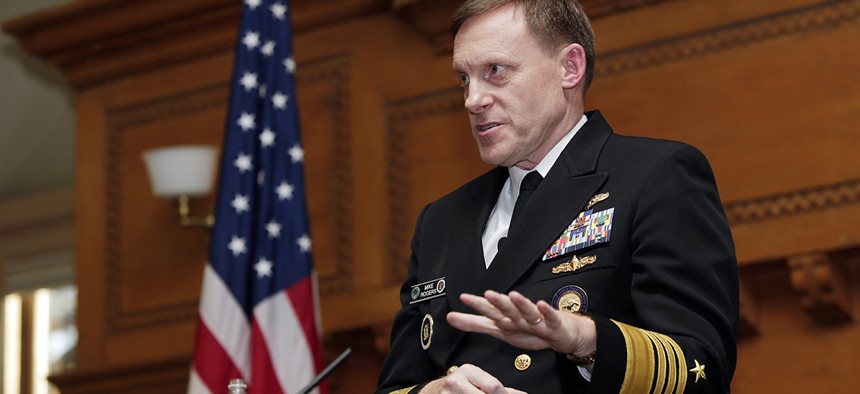Who’s Worried About the 96 Percent Retention Rate at NSA?

National Security Agency director Mike Rogers Marcio Jose Sanchez/AP
With such low turnover, Silicon Valley and other parts of the private sector might outperform NSA in snapping up fresh talent.
An unlikely figure is worried that the National Security Agency managed to hang to more than 90 percent of its science, technology, engineering and math whizzes last year: NSA Director Adm. Mike Rogers.
With claims of 545,000 unfilled U.S. IT jobs, it might seem counterintuitive that a leader maintaining a workforce of 30,000 coders and data analysts is concerned about too much loyal talent.
But with such low turnover, Silicon Valley and other parts of the private sector might outperform NSA in snapping up fresh talent, Rogers explains. Agencywide, the retention rate was 96.7 percent in 2015, while less than 10 percent of "high-end" computer scientists and mathematicians left, he said.
With a 3.7 percent attrition rate, it would 30 years to "recapitalize" the NSA workforce, Rogers noted.
"How do you make sure that we maintain our agility, our technical proficiency and our expertise across a broad set of problem sets if we’re only bringing three percent of the workforce in a year?" Rogers said in an address at the Atlantic Council last week.
The departing NSA personnel included retirees and people headed for jobs outside the agency.
The reasons employees stay put stir pride, Rogers said, but he would prefer there be an exchange program where startup upstarts and intelligence veterans can rotate in and out of government.
"They love the mission. They love the ethos. They love the culture and they believe in what they are doing,” Rogers said, but "how can we bring in people from the private sector who would work with us for a year or two?"
Cybersecurity training programs might need an upgrade to help this cause.
NSA-certified colleges and universities that offer special courses to prepare co-eds for cybersecurity jobs in both the public and private sector lack cachet, according to according to an October 2015 report from the National Academy of Public Administration on the government’s role in cybersecurity education.
"Private-sector employers don’t see" these so-called centers of academic excellence, or CAEs "as a meaningful credential," wrote the report's co-authors -- former Pentagon Chief Information Officer David Wennergren; president of Barquin International; Shelley Metzenbaum, a senior adviser to the Volcker Alliance and former White House budget official; and Alan Shark, executive director of the Public Technology Institute. "Some of the country’s most prestigious universities that produce technically accomplished graduates with computer security knowledge are not CAEs."
Today, Rogers' strategy for keeping NSA on the cutting edge is to establish teams, comprising experienced NSA personnel and newly hired junior workers, who can look at challenges from unique life perspectives, he said.
Relying on youth for new ideas carries risks too.
Last April, Sara Ratcliff, director of the human capital management office in the Office of the Undersecretary of Defense for Intelligence, said a quarter of millennials are turning over in the spy community.
The talent under age 30 want "great technology; they want good spaces to work in; they want lots of development opportunities; they really want and expect all of those things,” NSA’s human resources technical director, John Yelnosky, said at the time. “And there are employers who are more advanced than we are in providing that whole package."
There is acknowledgment that misgivings about the agency’s surveillance techniques might deter techies in the nonprofit and corporate worlds from considering a stint at NSA.
"One of the things I think that has hurt us in this trust thing is No. 1 is the nature of intelligence," Rogers said. "For good reason, we don’t talk much about the particulars. Even as people with very legitimate concerns, law abiding citizens, are listening to what I say, ISIL and a whole lot of other groups are listening to what I say. We’re always mindful of that in a public forum."






